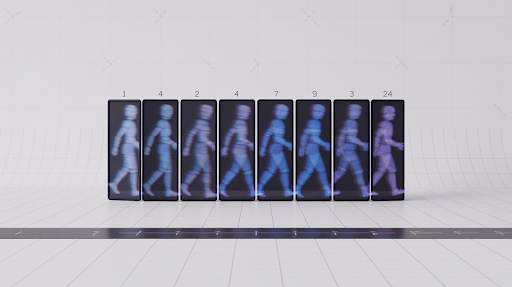Animation is built one frame at a time. Each animation frame carries a purpose: defining movement and emotion which adds direction to the story, shaping how viewers experience motion. The stretch of a jump, the blink of an eye, or a character’s pause for thought all depend on precise frame design and timing.
Each type of frame serves a distinct role in building motion and realism. Key frames mark action, in-betweens smooth transitions, and hold frames create emphasis. Together, they transform static visuals into meaningful motion.
This guide explains the types of frames in animation, their purpose, and how they bring characters and stories to life with clarity and depth.
What Is a Frame in Animation?
A frame is a single still image within an animation sequence. It works on the basis set by the zeotrope. When these images play rapidly, the eye reads them as continuous motion. This process turns still visuals into believable movement that carries life and energy.
Most animations run at 24 frames per second (fps). That means 24 separate images appear every second to create smooth, natural motion. The number of frames directly affects pacing, realism, and impact.
Why Frames Matter in Animation
Frames shape how the viewer feels a scene. In a video animation, every blink, wave, or leap depends on the timing between frames. A few extra frames can soften a move. Fewer frames can make it punchy. This is why animation frames are the soul of motion.
Without proper framing, animation looks flat or mechanical. Frames add weight, emotion, and life.
How Frame Animation Works
Frame animation is a technique where each image differs slightly from the last. When played quickly, these changes create motion. Think of a flipbook. Each page holds a new pose. Flip them fast, and the character dances to life.
That’s frame animation in essence simple, direct, and powerful. Today, it’s a foundational method used in motion graphics, where modern software automates parts of the process. But the core idea remains the same: motion through sequence.
Types of Frames in Animation
Different frames serve different storytelling needs. Let’s break down each animation frame type and its role.
-
Key Frames
Key frames mark the main actions in a sequence. They show the start and end of a motion. For example, when a character jumps, one key frame shows the crouch. Another shows the landing. Key frames define the structure of an animation. They are the roadmap animators follow.
-
In-Between Frames (Tweens)
In-betweens fill the gap between key frames. They smooth transitions and make motion look fluid. Today, software can create these automatically. Yet skilled animators refine each animation frame to preserve emotion and realism.
-
Extreme Frames
Extreme frames push motion to its limits. They show the highest or lowest point of an action. For instance, a punch fully extended or a stretch at its peak in a 3D animation. These frames exaggerate emotion and make movement dynamic.
-
Breakdown Frames
Breakdowns explain how an object moves from one extreme to another. They guide arcs, curves, and transitions. Without them, motion feels rigid. Breakdown frames add flow and rhythm.
-
Hold Frames
Hold frames stop the motion briefly. They add emphasis or anticipation. A character might freeze before reacting. This short pause builds tension or humor.
-
Layout Frames
Layout frames plan the scene. They map camera angles, background, and movement paths. These frames are the foundation for consistent storytelling and visual balance.
How Frame Rate Impacts Motion
More frames make smoother movement. Fewer frames make stylized or snappy motion. Frame rate controls how smooth motion appears. The key is to balance the story before speed.
- 12 FPS: stylized or minimal animation
- 24 FPS: cinematic standard
- 30 FPS: broadcast quality
- 60 FPS: ultra-smooth or realistic motion
What Defines a Good Animation Frame
Every animation frame has the potential to convey a meaningful message. It’s important that each frame is crafted with intention and care, as it contributes to the overall story and emotional impact.
Ask these three questions:
- Does it drive the story?
- Does it feel natural?
- Does it connect emotionally?
Why Frame Animation Feels Real
Frame-by-frame movement mimics real physics. Gravity, weight, and timing appear believable. Although there is a huge difference between animated vs cartoon content, cartoon animation frames still follow physical logic. When a ball bounces, its spacing changes.
The closer the frames, the slower the motion appears. Frame animation lets animators control every nuance of timing and tension.
Types of Animation Frames in Traditional and Digital Workflows
The debate of CGI vs traditional animation highlights how technology has reshaped frame creation. Both styles use the same principles but differ in tools, timing, and creative approach. Here is how the frame works differently for both approaches:
- In traditional animation, each frame was hand-drawn. Artists planned timing using exposure sheets.
- In digital animation or CGI Animation, frames are created on software timelines. Keyframes anchor the motion, and in-betweens fill gaps automatically.
The workflow has evolved, but the creative control stays the same.
Why Understanding Frame Types Improves Storytelling
Frames act as emotional cues that guide how viewers respond to motion. Each frame shapes feeling through timing and rhythm. A pause builds tension. A quick burst creates energy. A slow, steady move brings calm and focus.
Deeply understanding the types of frames in animation allows artists to control emotion with precision. Every frame choice influences how the story connects with the audience, turning motion into meaning and rhythm into emotion.
FAQs
How do animation frames influence viewer emotions?
Animation frames shape timing and rhythm, which directly impact how emotions are conveyed. A sudden pause can build suspense, while fluid motion creates a sense of calm or elegance.
What’s the difference between keyframes and pose-to-pose animation?
Keyframes are specific drawings that define the start and end of an action. Pose-to-pose animation is a broader method where keyframes are drawn first, followed by in-betweens to connect them.
Can frame animation be effective for explainer or brand videos?
Yes, frame animation is one of the most effective styles for explainer videos. At Animatedvideos.co, we use frame-based animation to simplify complex messages and create scroll-stopping visuals tailored to your brand’s voice and goals.
Do higher frame rates always mean better animation?
Not always. Higher frame rates create smoother motion but may lack character or stylization. It depends on the narrative and style you're aiming for.
Why do animators still rely on traditional frame techniques in digital workflows?
Animators have complete control over character movement, expression, and timing when using traditional frame techniques. These guidelines guarantee excellent storytelling and more emotionally compelling outcomes even in digital animation.
What’s the role of frame spacing in creating natural motion?
Weight and perceived speed are influenced by frame spacing. Motion is sped up by wider spacing and slowed down by closer spacing. Changing the spacing gives character movements more realism and helps replicate real-world physics..
How does frame animation differ from motion capture animation?
Frame animation is drawn or generated manually, allowing complete artistic control. Motion capture uses real actor movements, which can be efficient but less stylized. Frame animation is ideal for custom storytelling with a unique visual feel.
How can brands benefit from custom frame animation?
Custom frame animation allows for storytelling that matches your brand's identity, tone, and goals. At Animatedvideos.co, we craft each frame with purpose to help businesses connect with audiences more memorably and effectively.
What’s the best frame rate for online animation content?
24 frames per second strikes the ideal balance between style and smoothness for the majority of web content. While 60 fps is ideal for high-performance or game-related animations, 30 fps is also supported by websites like YouTube and social media advertisements.
Conclusion
Frames define how stories move. From keyframes to holds, each one adds meaning, rhythm, and life. The types of frames in animation control not only motion but also emotion. They turn ideas into movement, and movement into impact.
At Animatedvideos.co, we bring motion to meaning. Every frame is crafted for clarity, rhythm, and story. Our animation experts design sequences that move hearts and brands alike. Choose precision. Choose artistry. Choose us where every frame speaks your story.



